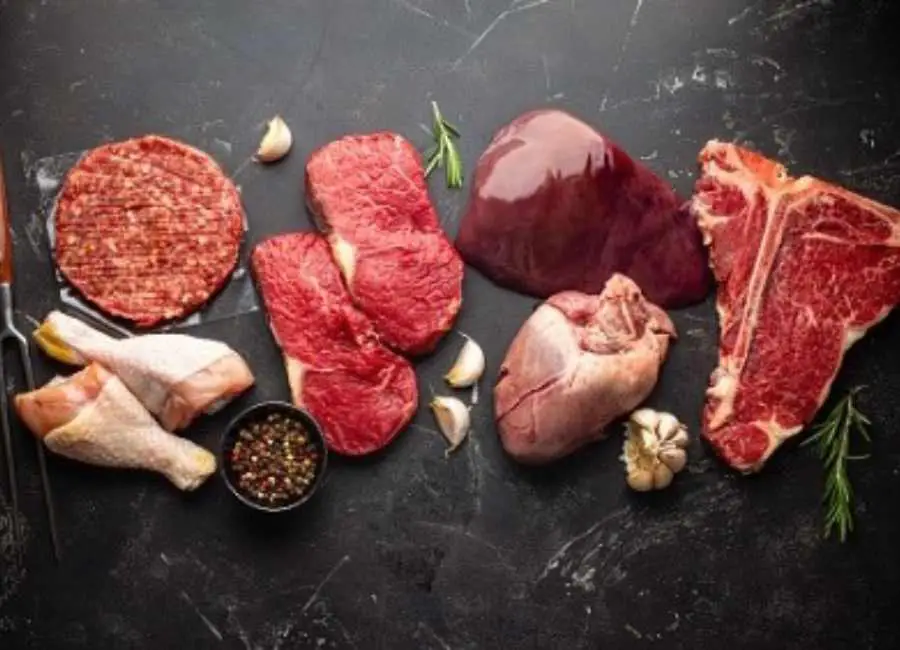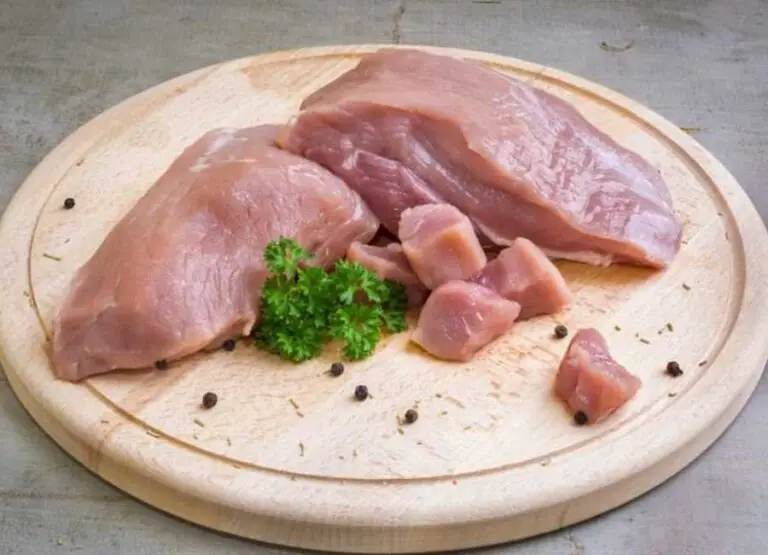3 Major Types of Meat You Should Know
Here are the 3 basic types of meat you should know, the main sources, the best way of consuming it, disadvantages, and current Government advice.
Read through to find out types of meat which is different from sources.
What is Meat?
Meat is the edible tissues from an animal that could live in sea, land, or air and is consumed as food, especially or mostly in solid form but could be converted into other forms.
Meat can include the flesh, fat, muscles, and offal of any animal. The offal is the internal parts of the animal such as the liver, kidney, and tongue.
According to the USDA, the United States is the largest producer of beef. The meat industry is actually one of the largest in the world.
Is Meat Good & Healthy for Consumption?
Meat becomes unhealthy when you eat too much of it. It is important to note that animal protein has many benefits when ingested in small quantities.
Depending on the animal and how it was raised, most meats contain high levels of vitamin B12, B6, and K, as well as zinc and iron.
Always remember that fit animals will yield leaner and more tender muscle tissue, than unfit animals.
Over-processed meat products can be full of unhealthy chemicals and preservatives.
So it’s important to consider your processing method as this is a big factor when trying to answer the question like is meat good & healthy for consumption?
Each type of meat and animal product has an internal temperature it should reach by the end of cooking to meet food safety standards, as consuming raw meat can be very dangerous.
Finally, it’s important to also note that most Grass-fed animals are always healthier than grain-fed animals. So it is 100% healthy to consume meat if such meat meets food safety standards.
Types of Meat
Here are the three main types of meat that are available.
- Red meat: Beef, Goat, Lamb, etc.
- White meat: Chicken, Turkey, etc.
- Seafood: Fish, Crab, Lobster, etc.
Red Meat
Red meat is commonly red when raw and has a dark color after it is cooked, in contrast to white meat, which is pale in color before and after cooking.
Only flesh from mammals or fowl is classified as red or white, red meat has more protein myoglobin than white meat.
It is important to note that some meat such as pork, is classified as white meat under the common or culinary definition, but as red meat under the nutritional definition.
Red meat includes:
- Beef
- lamb and mutton
- pork meat
- veal
- venison
- goat meat
Benefits of Red Meat;
1. Red meat contains high Iron and Iron is needed to help red blood cells transport oxygen.
2. Red meat is a rich source of protein and protein helps in bodybuilding.
3. Red meat is a good source of Zinc and Zinc is required by the body for DNA synthesis and helps the immune system to function effectively.
4. Red meat is a rich source of vitamins and Vitamins are beneficial for the immune system and also the nervous system.
Recommended Intake of Red Meat
The Department of Health advises people to consume 90g or less of red meat per day. A thin slice of pork, lamb, or beef the size of half a slice of bread provides about 30g of meat.
Products of Red Meat
- Hotdogs
- Sausages
- Burgers
- Corned beef
- Salami
- Jerky
- bacon
- ham
- pâtés
- canned meat such as corned beef
- sliced luncheon meats. Etc
Red Meat Cooking & Hygiene
Raw red meat can contain harmful bacteria. Therefore, red meat must be stored, cooked, and processed properly.
Wash your hands after handling raw meat, and wash utensils and dishes for raw meat.
Red meat should not be heated more than once to avoid food poisoning.
When cooking red meat, heat it completely to ensure that the bacteria inside the meat are destroyed.
What Animals Considered as Red Meat?
The following animals are considered red meat animals which include: Cattle, sheep, goats, buffalo, bison, water buffalo, deer, reindeer, moose, caribou, elk, boar, pigs (most cuts of pig meat), hares, yaks, horses, camels, llamas, alpacas, kangaroos, goose, ostrich, and emu.
Best Ways to Consume Red Meat
If at all possible, go for leaner beef. Also, lowering the heat when you cook helps the beneficial molecules not freak out and lose their shape, and thus you reap all the nutritional benefits of that juicy steak
Chili and stew are great ways to let that meat simmer and keep the flame low. Or, to help with that balance, make sure to add vegetables to your meal with stuffed bell peppers and zucchini boats.
Disadvantages and Health Effects of Eating Red Meat
Eating red meats is related to the amount of intake of fat, cholesterol, and sodium content.
These risk factors bring an increasing rise in heart diseases, such as heart attacks and clogged arteries.
High sodium content in red meats can lead to high blood pressure.
As of when this post was made the health effects of red meat are unclear.
However, the above effects are just speculation, with no scientific proof.
Read more about meat:
- 6 Major Red Meat Sources You Should Know.
- 12 Reasons Why Can Animals Eat Raw Meat & We Can’t.
- Can Red Meat Cause Constipation: What You Should Know.
White Meat
white meat is meat that is pale in color before and after cooking, or a slice of meat such as chicken or veal that is pale in color, or the whitest flesh, usually the breast, of a cooked bird.
A clear example of white meat is the lighter-colored meat of poultry, coming from the breast, as contrasted with dark meat from the legs.
It is important to note that white meat includes poultry and fish, but excludes all mammal flesh, which is considered red meat.
White Meat Includes meat coming from;
- chicken
- turkey
- duck
- goose
- game birds
- rabbit
Benefits of White Meat
1. White Meat contains All the right vitamins in the right proportions
2. White Meat has the ability to Better heart health because chicken breast defeats and controls homocysteine levels.
It is important to note that high levels of amino acid homocysteine are high in the body, and can cause cardiovascular disease.
3. White Meat Prevents bone loss because it contains an adequate amount of calcium and protein and is also rich in phosphorus, which is an essential mineral that supports your teeth and bones, as well as the kidney, liver, and central nervous system function.
Recommended Intake of White Meat
According to the U.S. Department of Agriculture, 28 grams (1 oz) of boneless, skinless turkey breast contains about one gram of fat, compared with roughly two grams of fat for 28 g (1 oz) of the boneless, skinless thigh.
The numbers go up when the skin is kept in: a chicken thigh, with skin intact, has 13 grams of total fat and 3.5 grams of saturated fat per 85 g (3 oz) serving; this is about 20 percent of the recommended maximum daily intake.
Animals Considered as white Meat are;
- chicken
- turkey
- duck
- goose
- pheasant
- rabbit
- sea animals with and without shells
- most flying birds
- alligators
- crocodiles
Best Ways to Consume White Meat
Adding vegetables and even fruit will help you diversify the nutrition of any recipe, and will nourish your body without taking away from the taste.
Cooking with low heat (and not chucking it in a pool of oil) helps to maintain the nutritional benefits of chicken and keep your meals healthy.
Slow cooking is a great way to accomplish this, and you can even have a slow cooker in your dorm room.
Disadvantages and Health Effects of White Meat
1. There are fewer calories when it comes to white meat, the consumption of white meats has the advantage that if you eat 100 g of chicken the calories would be 165.
Whereas consumption of 100 g of beef the calories would be around 470. Hence white meat provides you with sufficient proteins along with fewer calories.
2. white meat is generally considered as having a better taste than red meat. Not to forget that there are many people who prefer red meat simply for its taste as it tastes juicier than white meat.
3. White Meat lacks nutrients that red meat offers such as riboflavin and thiamin.
4. A lot of chicken raised in the agricultural industry is treated with hormones that allow faster growth. Some of these chickens are actually fed with arsenic, which is used to poison rats.
White Meat Cooking & Hygiene
Always cook white Meat with low heat to get the best out of it, both nutrition-wise and Healthwise.
One of the best ways to consume white meat is to make sure they are organically raised to have minimal cons of consuming this meat.
Summary of Red Meat Vs White Meat
What is the difference between the two?
In general, types of meat in the “red meat” category are red before and sometimes after cooking.
The reason meats such as beef, lamb, and venison are red is that they are high in a protein called myoglobin.
This is an iron-rich protein that gives certain types of meat their red color.
In general, types of meat in the “red meat” category are red before and sometimes after cooking.
The reason meats such as beef, lamb, and venison are red is that they are high in a protein called myoglobin.
This is an iron-rich protein that gives certain types of meat their red color.
Pork meat is also classified as red meat and some parts as white meat because it contains higher levels of myoglobin than white meat such as chicken.
Pork is lighter in color than beef and becomes very light when cooked but it is still red meat.
Types of white meat, such as some types of poultry, contain less myoglobin and therefore are white in color.
However, because myoglobin occurs in muscles, darker meat from chickens and turkeys is found on their legs and thighs.
Seafood
Seafood is any marine life that humans consider food, with fish and crustaceans in the foreground.
Mollusks include various types of mollusks (eg crustaceans such as mollusks, oysters, mussels, cephalopods such as octopuses and squid), crustaceans (eg shrimp, crabs, crayfish), and echinoderms (eg sea cucumbers, sea urchins).
In the past, marine mammals such as whales (whales and dolphins) and seals were eaten as food, but today they are less common.
List of Seafood or Animals Considered as seafood
Here are a few lists of Seafood, there are many of them but I will provide a few.
Mollusca (Cockle, Cuttlefish, Clam, Loco, Mussel, Octopus, Oyster, Periwinkle, Scallop, Squid, Conch, Nautilus.
Marine mammals (Dolphin, Seal, Whale).
Crustaceans (Crab (Dungeness crab, mud crab, sand crab, king crab, and snow crab), Crayfish, Langostino also known as the squat lobster.
Lobster (American lobster, rock lobster, spiny lobster, and red lobster), Shrimp (prawns).
Roe (Caviar (sturgeon roe), Ikura (salmon roe), Kazunoko (herring roe), Lumpfish roe, Masago (capelin roe), Shad roe, Tobiko (flying-fish roe), )
Fish (Anchovies, Barracuda, Basa, Bass, Black cod/Sablefish, Blowfish, Bluefish, Bombay duck, Bream, Brill, Butterfish, Catfish, Cod (Pacific cod and Atlantic cod), Dogfish, Dorade, Eel, Flounder, Grouper), etc.
Benefits of Eating Seafood
Here are some benefits of eating Seafood you may not have heard about:
1. Seafood Can Help Fight Against Depression
New research on omega-3s found in seafood shows that eating seafood can help reduce your risk of depression, as well as treat depression and make you more positive about your ideas.
2. Seafood is Filled With Nutrients
One important thing to remember about seafood is that not only is it a little bad, but there are many good things as well.
Seafood is rich in nutrients such as B vitamins, B-complex vitamins, and vitamin A. Some fish, such as tuna, are rich in vitamin D, which is good for bones and the immune system.
3. Seafood Can Give You Better Skin
The omega-3 and fatty acids in seafood can help moisturize the skin, reduce acne and protect the skin from UV rays.
4. Seafood is Good for Your Heart
Seafood is high in protein and low in saturated fat, also filled with that omega-3s that can really help with heart health and reduce the risk of cardiovascular events.
5. Seafood Help Maintain Eyesight.
Omega 3 fatty acids are very important and again when it comes to seafood and eyesight eating seafood regularly can actually help your vision and prevent vision decline.
Another fun fact is that fish and shellfish can also boost your night vision.
6. Seafood Boosts Your Brain
The good news is, the omega-3s in seafood can just boost your brain.
They help with brain growth in infants and children, can boost cognitive function in aging women, and can help lower the risk of developing Alzheimer’s disease.
Disadvantages of eating Seafood
1. Some Seafood lack most nutrients, Fishes like the Tilapia do not have the omega-3 that makes other fishes good.
2. Seafood most times could cause extreme allergic reactions. If you are not sure that you are allergic to seafood or not, get tested first.
3. Seafood has high levels of mercury, and mercury has been proven to stop the development of a baby. Pregnant women should be careful with the seafood they consume.
4. Due to the levels of pollution in the oceans, seafood is often contaminated. It could cause mild to severe poisoning.
Recommended Intake of seafood
The Dietary Guidelines for Americans recommends that adults consume about eight ounces per week of a variety of seafood, including at least some choices higher in the omega-3 fatty acids EPA and DHA, because seafood has been associated with heart health benefits.
People can consume more seafood than the amounts recommended in the Healthy U.S.-Style Eating Pattern (e.g., more than eight ounces for those consuming 2,000 calories a day), but should focus on seafood choices that are low in methyl mercury.
More on meat:
- 10 Most Unhealthy Meat & 5 Most Healthy Meat.
- How Much Smoked Meat Is Safe To Eat: The Bottom Line.
- How Is Meat Bad For You: 10 Risk Factors You Should Know.



![Why Is My Frozen Ground Beef Brown [Answered]](https://foodcreeks.com/wp-content/uploads/2023/03/Frozen-Ground-Beef-Brown-768x555.jpg)
![Can Pregnant Women Eat Uncured Meat [Answered]](https://foodcreeks.com/wp-content/uploads/2023/02/Can-Pregnant-Women-Eat-Uncured-Meat-768x555.jpg)


